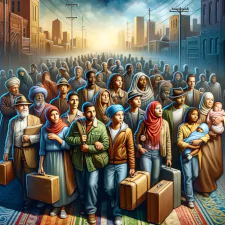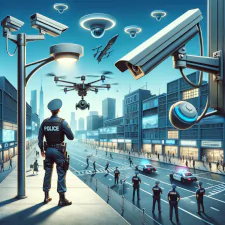A Study in Strategic Demonizing
A State Threat: How Easy Is It To Demonize People, a Study in Strategic Demonization. Sorry, we are not talking about the 1998 Will Smith, Gene Hackman movie “Enemy of the State”. However, the movie does show exactly how Politicians craft the image of ‘Enemies Of The State’. We delve into this powerful political strategy. Historically employed by diverse political groups to solidify power, shape public discourse, and rally collective support. This exploration offers an in-depth analysis of the methods and motives behind this practice.
Key Take Aways:
- Psychological Simplification: The innate human tendency to categorize others as “us” vs. “them” simplifies complex social dynamics, making it easier to vilify certain groups or individuals.
- Political and Social Amplification: Governments and media can exploit pre-existing prejudices, amplifying fears and stereotypes. This paints a group as a significant threat, even without a factual basis. Attempting to consolidate power or divert from domestic issues.
- Repetition and Broad Categorization: The strategy involves repeating negative portrayals and using broad categorizations (e.g., labeling entire communities as threats). Which in turn, ingrains these perceptions in public consciousness and justifies harsh policies.
Table of Contents
- Why is it easy to create an Enemy of the State?
- Defining an Enemy of the State:
- Crafting Narratives:
- Propaganda and Media:
- Repetition and Ingraining The Enemy
- Legal and Institutional Measures:
- Enemy Surveillance and Policing Tactics
- Immigrants The Enemy of The State
- Enemy of the State
- Frequently Asked Questions:
- Why is it easy to be labeled an enemy of the state?
- What role does media play in creating enemies of the state?
- What are some historical examples of creating enemies of the state?
- How do political leaders benefit from creating an enemy of the state?
- What methods are used to create and maintain the perception of an enemy of the state?
Why is it easy to create an Enemy of the State?
Making an enemy of the state is easy due to human psychological tendencies to simplify complex groups into “us vs. them”. This is amplified by political and media strategies that exploit fears and stereotypes. This process involves demonizing certain groups or individuals through repetition and broad categorizations. There by embedding these negative perceptions in public consciousness and legitimizing harsh policies against them.
- Politically: governments or leaders might find it beneficial to unify their populace against a common enemy, thereby consolidating power and diverting attention from domestic issues.
- Socially: media and propaganda can effectively amplify fears and prejudices, painting a person or group as a significant threat, even if the portrayal is exaggerated or unfounded.
This process of creating an enemy often relies on pre-existing stereotypes or grievances, making it easier to persuade the public to accept and support the vilification of the chosen target.
Defining an Enemy of the State:
Identification and Labeling The Enemy

A contemporary example of this can be seen in North Korea’s portrayal of the United States and South Korea. The North Korean government consistently labels these nations as imperialist aggressors, posing a constant threat to its sovereignty.
This narrative is deeply ingrained in North Korean society. The U.S. and South Korea are depicted as the primary external enemies. Responsible for the nation’s hardships and challenges. This serves to justify the regime’s militaristic and isolationist policies, rallying the population around a common adversary.
Identification and Labeling (U.S. Immigration)
In the context of U.S. immigration, migrants, particularly those from Latin and Muslim-majority countries, are seen as threats. A Political narrative crafted to label immigrants as threats to both national security and American jobs.
This labeling has been a central theme in political campaigns and policies. Painting a picture of immigrants as potential criminals or economic burdens.
Such portrayals have been used to justify strict immigration policies and border control measures. Including the construction of border walls and travel bans. This strategy of defining immigrants as a national threat has been effective by rallying a segment of the electorate and public opinion around stricter immigration policies.
Broad Categorizations
Inclusiveness
Russia’s approach to labeling various non-governmental organizations (NGOs) and opposition figures as “foreign agents” or “extremists” illustrates broad categorization. This tactic is used to paint a wide array of groups and individuals, from human rights activists to political opponents, as threats to national security. By using these broad terms, the Russian government effectively clamps down on dissent. While portraying these diverse groups as part of a larger, hostile force against the Russian state.
Donald Trump’s Muslim Ban

Former President Donald Trump’s executive order, commonly referred to as the “Muslim Ban,” serves as a modern example of broad categorization in the context of defining enemies of the state. This policy initially targeted several Muslim-majority countries, barring entry to the United States for citizens from these nations.
The rationale provided was national security and the prevention of terrorist entry. However, the broad nature of the ban sparked criticism and accusations of discrimination and xenophobia.
By categorizing an entire religious and ethnic group as potential threats
The policy simplified complex global and domestic security issues. It also reflected the strategic demonization where a whole community was portrayed as a potential enemy. Regardless of the individual variations and contributions of people from those countries. This approach stirred significant public debate, outrage, and legal challenges. Including international reactions, highlighting the impact of such broad categorization in modern policy-making.
Crafting Narratives:
Promoting Fear and Urgency
The U.S. government’s response post-9/11 exemplifies this point. The narrative of a war on terror was quickly established. Portraying terrorism as an imminent threat to national and global security. This narrative of fear and urgency led to widespread public support for military actions. That included both Afghanistan and Iraq, along with significant changes in domestic security policies and practices. One of those domestic policies is the Patriot ACT.
Simplification and Generalization
China’s Narrative
Around the Uighur population in Xinjiang serves as an example. The Chinese government simplifies the complex issue of ethnic and religious tensions. Simply by portraying Uighur separatism and Islamic extremism as one issue. This generalization justifies harsh policies, including mass surveillance and reeducation camps. All under the guise of combating terrorism and maintaining national unity.
Simplification and Generalization (U.S. Immigration)
The issue of immigration in the U.S. often gets simplified into a general narrative of protecting borders and jobs. However, there are complex factors driving immigration from migrant’s home countries such as:
- Violence
- Poverty
- Political instability
This simplified generalization diminishes the contributions of immigrants to the U.S. economy and culture. As well, this generalization creates a singular view of immigrants as either illegal invaders or job stealers. All the while neglecting the nuanced realities of migration and its multifaceted impact on American society.
Propaganda and Media:
Iran’s Use of State-Controlled Media
A relevant example is Iran’s use of media to shape public opinion about Western nations. Particularly, when it comes to the United States and Israel. The government extensively uses its media outlets to disseminate narratives depicting these countries as enemies of Iran. Very intent on undermining its sovereignty and Islamic values. This propaganda is aimed at rallying domestic support for the regime and its policies.
U.S. Right-Wing Media

The Role of Media in State Propaganda
In U.S. right-wing media, there is a notable trend of propagating negative narratives that align with conservative ideologies and policies. These media outlets play a crucial role in shaping public opinion on various issues including but not limited to:
- Immigration
- Gun Rights
- Climate change
- LGBTQ
Media outlets, using these negative narratives, present these topics in a manner that supports conservative viewpoints while discrediting opposing perspectives. Not only does this approach reinforce existing beliefs among their audience. It creates a polarizing public opinion by creating a divide in how different segments of society perceive key issues.
Repetition and Ingraining The Enemy
Tell a lie long enough and it becomes the truth

Venezuela under Hugo Chávez and Nicolás Maduro demonstrates this through the constant portrayal of the United States as an imperialist enemy. This narrative, repeatedly broadcasted through state media and political speeches, has ingrained the idea of U.S. hostility in the Venezuelan public consciousness, legitimizing the government’s anti-American stance and policies.
In the United States, migrants are portrayed as “Enemies of the State,” largely through the use of repetition and ingraining in public discourse. This process often involves repeatedly presenting migrants as a threat to social, economic, or national security. Politicians, certain media outlets, or influential public figures might continuously emphasize narratives that associate migrants with crime, economic burdens, or cultural challenges.
This consistent repetition can effectively ingrain these perceptions into the public consciousness. As these messages are echoed across various platforms—be it through:
- News cycles
- Social media
- Political rhetoric
They can become deeply embedded in societal attitudes. This often leads to a situation where the public begins to perceive migrants not as individuals seeking better opportunities or refuge, but as a homogenous group posing a threat.
The repetition and ingraining method is powerful because it leverages familiarity and confirmation bias, where people tend to accept information that aligns with their pre-existing beliefs and ignore information that contradicts them.
In this context, even when presented with evidence or narratives to the contrary, the ingrained perceptions can persist, making it challenging to change public opinion. This phenomenon has real-world consequences, influencing immigration policies, affecting the integration of migrants, and shaping the overall societal attitude toward them.
U.S. 2020 Election: ‘Stolen Election’ Narrative
Following the U.S. 2020 Presidential Election, the narrative of a ‘stolen election’ was prominently propagated by former President Donald Trump and supported by various right-wing media outlets and political figures.
Despite the lack of evidence to support claims of widespread voter fraud, the repetition of this narrative created a significant belief among a portion of the electorate that the election was illegitimate.
This constant reiteration of the claim, through social media, press conferences, and political rallies, ingrained the idea of a stolen election in the minds of many, leading to widespread skepticism and mistrust in the electoral process.
Legal and Institutional Measures:
Legislation Targeting the Enemy
Turkey’s approach to dealing with the Kurdish population and associated political entities provides an example. The Turkish government has enacted various laws and regulations targeting Kurdish activism and political representation, often under anti-terrorism pretexts.
These legal measures enable the state to crack down on Kurdish political movements, framing them as threats to national unity and security.
U.S. Immigration

In the United States, legislation targeting immigration has been a prominent example of how laws can be used to define and manage perceived ‘enemies of the state.’ A notable instance is the implementation of stricter immigration policies and reforms under various administrations.
These have included measures like the Zero Tolerance Policy, which led to family separations at the U.S.-Mexico border, and revisions to the public charge rule, making it harder for immigrants receiving government benefits to obtain legal status.
Such legislative actions frame immigration as a legal and security issue, with immigrants often being depicted as a threat to domestic job markets, public resources, and national security.
This legal approach towards immigration not only reflects the strategic demonization of a group but also institutionalizes the perception of immigrants as a problem to be managed, shaping public discourse and policy for years to come.
Enemy Surveillance and Policing Tactics

China’s extensive surveillance program in Xinjiang is a stark example. The Chinese government employs a massive surveillance apparatus to monitor the Uighur Muslim population, using advanced technologies like facial recognition and AI-driven monitoring. This heightened surveillance is part of a broader strategy to control and suppress Uighur identity and dissent against the state.
Mobilizing Support:
Creating an Enemy ‘Us vs. Them’ Mentality

The Brexit campaign in the United Kingdom showcased this tactic. The narrative constructed by pro-Brexit campaigners framed the European Union as a controlling entity, infringing on British sovereignty. This ‘us (UK) vs. them (EU)’ mentality was effective in rallying public support for Brexit, simplifying complex socio-economic issues into a battle for national independence and identity.
U.S. 2020 Election and Jan 6, 2021
The aftermath of the U.S. 2020 Presidential Election and the events leading up to January 6, 2021, are illustrative of how an ‘us vs. them’ mentality can mobilize support and lead to significant political action. Following the election, narratives claiming a stolen or rigged election were widely propagated by then-President Donald Trump and his allies.
This rhetoric intensified the division between supporters and opponents, framing the situation as a battle between those defending democracy (as they perceived it) and those accused of undermining it.
This polarizing narrative reached its zenith with the January 6 Capitol riot, where a segment of Trump’s supporters, fueled by claims of electoral fraud and calls to ‘stop the steal,’ stormed the U.S. Capitol.
This event underscored the power of mobilizing support through divisive and polarizing rhetoric, demonstrating how an ‘us vs. them’ narrative can escalate from political rhetoric to real-world, consequential actions.
The incident remains a stark example of the potential outcomes when a significant portion of the populace is rallied under a common cause, especially one grounded in contentious and disputed claims.
Immigrants The Enemy of The State
Throughout history, immigrants have often been the centerpiece of “enemy creation” strategies, exemplifying various aspects of this phenomenon. Particularly during economic downturns or social unrest. They have been portrayed as threats to:
- National security
- Economic stability
- Cultural purity
This portrayal serves as a prime example of:
- Identification
- Labeling
The above technique is often used to cast a wide generalized net over diverse immigrant populations to name a group as an enemy. In times of societal strain, these individuals are conveniently blamed for:
- Stealing jobs
- Inciting crime
- Diluting national culture.
This narrative is typically amplified by certain media factions, particularly right-wing outlets, which propagate these views, leading to increased fear and distrust among the native population.
Others or Outsiders
The portrayal of immigrants as “others” or “outsiders” is a classic example of creating an ‘us vs. them’ mentality, making it easier for governments or influential groups to scapegoat them for broader societal problems.
By emphasizing differences in:
- Language
- Religion
- Customs
Immigrants are depicted as unwilling to assimilate, framing this perceived resistance as a rejection of the host nation’s values and a threat to its identity. This narrative may even evolve to accuse immigrants of having ulterior motives:
- Espionage
- Terrorism
- Increasing public paranoia and fear
Legislative Measures
Furthermore, legislative measures have been employed to reinforce the image of immigrants as enemies. Strict immigration policies, the establishment of detainment camps, and racial profiling are tools used to control the immigrant population and communicate to the native populace the perceived threat they pose.
These measures not only infringe upon the rights of immigrants but also serve to perpetuate the narrative of them as dangerous and unwelcome, showing how legal and institutional measures are strategically used in this context.
This comprehensive depiction of immigrants within the framework of “enemy creation” strategies illustrates the multifaceted approach taken by states and influential actors.
Fear-inducing Narratives
From crafting and disseminating fear-inducing narratives to implementing legal measures, the strategic demonization of immigrants encapsulates a broad spectrum of tactics used to define, vilify, and manage perceived enemies of the state.
The rendering of immigrants as enemies of the state is a strategic, calculated political maneuver, far beyond mere xenophobia or ignorance.
This approach capitalizes on:
- Deep-rooted fears
- Prejudices
To achieve specific political or societal objectives. The consequences of such a strategy are profound, often resulting in:
- Societal rifts
- Increased hate crimes
- Erosion of democratic values.
Simultaneously, it’s crucial to acknowledge the dire circumstances and terror that many immigrants are trying to escape in their home countries. While the complexities of illegal immigration are undeniable, empathizing with their plight is essential.
By putting ourselves in their shoes, we can better understand the desperation that drives them to seek a better life, reminding us of their inherent humanity despite the challenging and often polarizing nature of immigration issues. Always asking what if that were me?
Enemy of the State
The ease with which an “Enemy of the State” can be created is a testament to the powerful interplay of psychological biases, political strategies, and social influences.
This phenomenon exploits the human tendency to simplify complex social dynamics into two categories, allowing leaders to consolidate power by uniting people against a common adversary.
The role of media and propaganda in amplifying fears and prejudices cannot be overstated, as they are instrumental in shaping public perception and opinion.
Understanding these dynamics is crucial, as it not only reveals the mechanisms behind the creation of societal enemies but also highlights the importance of critical thinking and skepticism in resisting manipulative narratives that can lead to division and conflict.
Frequently Asked Questions:
Why is it easy to be labeled an enemy of the state?
It is easy due to human psychological tendencies to simplify social dynamics into “us vs. them,” allowing political leaders to exploit fears and stereotypes.
What role does media play in creating enemies of the state?
Media can amplify existing prejudices and fears, spreading propaganda that paints certain groups as significant threats to national security.
What are some historical examples of creating enemies of the state?
Examples include North Korea’s portrayal of the U.S. and South Korea, the U.S. labeling immigrants as threats, and China’s depiction of the Uighur population.
How do political leaders benefit from creating an enemy of the state?
Leaders can consolidate power, unify the populace against a common enemy, and divert attention from domestic issues.
What methods are used to create and maintain the perception of an enemy of the state?
Methods include repetition of negative portrayals, broad categorizations, legislative measures, surveillance, and media propaganda.

Saved as a favorite, I really like your blog!